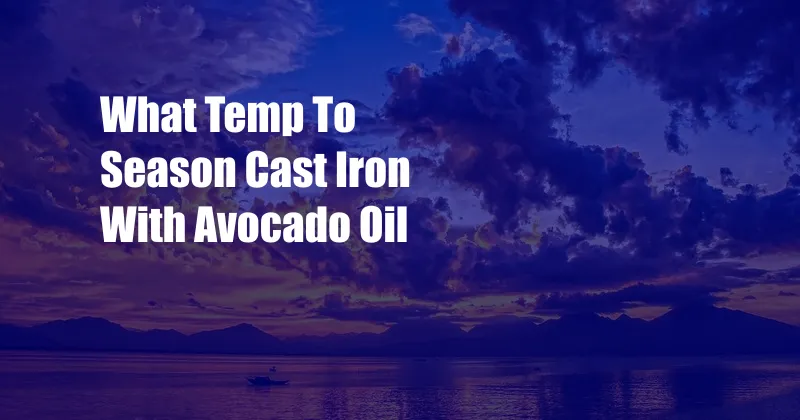
What Temperature to Season Cast Iron with Avocado Oil?
Cast iron cookware is a versatile and durable cooking tool that can last for generations. However, it requires proper seasoning to protect it from rust and maintain its non-stick properties. Avocado oil, with its high smoke point and healthy fats, is an excellent choice for seasoning cast iron.
Understanding the Seasoning Process
Seasoning cast iron involves creating a layer of polymerized oil on the surface of the pan. This layer acts as a barrier against rust and enhances the non-stick performance of the cookware. The process involves heating the oil to a high temperature and allowing it to bond to the iron surface.
Choosing the Right Temperature
The ideal temperature for seasoning cast iron with avocado oil is between 450°F and 500°F (232°C and 260°C). This temperature is high enough to polymerize the oil without burning it. Using a higher temperature can damage the pan and create a brittle seasoning layer.
Step-by-Step Seasoning Instructions
- Clean the pan thoroughly: Wash the cast iron pan with hot soapy water and scrub off any food residue. Dry it completely with a towel.
- Apply the oil: Use a paper towel or brush to apply a thin layer of avocado oil to the entire surface of the pan, including the handle and interior.
- Heat the pan in the oven: Preheat your oven to the desired temperature (450-500°F). Place the cast iron pan upside down on a wire rack in the oven.
- Bake for 1 hour: Bake the pan for 1 hour, or until the oil has polymerized and the surface has turned a dark brown or black color.
- Turn off the oven and let it cool: Leave the pan in the oven with the door slightly ajar to allow it to cool gradually.
Tips and Expert Advice
- Use pure, unrefined avocado oil for the best results.
- Apply multiple thin coats of oil rather than one thick layer.
- Allow the pan to cool completely between each coat.
- Avoid using soap to clean seasoned cast iron. Instead, wipe it down with a paper towel or use a chainmail scrubber.
- Season the pan regularly to maintain its non-stick properties.
Troubleshooting Common Seasoning Issues
- Flaky seasoning: This occurs when the oil is not polymerized properly. Re-season the pan by following the instructions above.
- Sticky seasoning: This can happen if the oil was applied too thickly. Remove the excess oil with a paper towel and re-heat the pan in the oven for 15-20 minutes.
- Rust on the pan: If the pan was not seasoned properly or stored in a humid environment, rust may develop. Scrub off the rust with a chainmail scrubber and re-season the pan.
FAQ
Q: Can I use other types of oil to season cast iron?
A: Yes, you can use other high smoke point oils such as vegetable oil, canola oil, or grapeseed oil. However, avocado oil is preferred for its health benefits and low absorption rate.
Q: How often should I re-season my cast iron pan?
A: Re-seasoning frequency depends on how often you use the pan. If you use it daily, you may need to re-season every few months. If you use it less frequently, you may only need to re-season once or twice a year.
Conclusion
Seasoning cast iron with avocado oil is an essential step to maintain its non-stick properties and protect it from rust. By following the instructions and tips outlined above, you can achieve a durable and well-seasoned cast iron pan that will last for years to come.
Are you interested in learning more about seasoning cast iron cookware? I encourage you to explore other resources and engage with the community to further your knowledge.